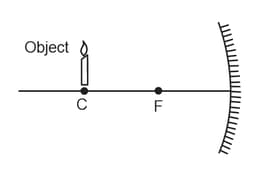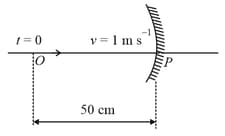What is the relation between radius of curvature and focal length of a spherical mirror?
Important Questions on Reflection of Light
| Object pin | Convex Lens | Convex Mirror | Image Pin |
| 22.2 cm | 32.2 cm | 45.8 cm | 71.2 cm |
The radius of curvature of a converging mirror is . At what distance from the mirror should an object be placed so as to obtain a virtual image?

Which of the following statements is not true in reference to the diagram shown above?
A student holding a mirror in his hand, directed the reflecting surface of the mirror towards the Sun. He then directed the reflected light on to a sheet of paper held close to the mirror.
Which type of mirror does he have?
An object of height is kept at a distance of from the pole of a diverging mirror. If the focal length of the mirror is , the height of the image formed is ____.
An object is placed at a distance of from a convex lens. A convex mirror of focal length is placed on another side of the lens at as shown in the figure. The image of the object coincides with the object.

When the convex mirror is removed, a real and inverted image is formed at a position. The distance of the image from the object will be
In which of the following is a concave mirror is used?
What should he do to burn the paper?
A point object is moving uniformly towards the pole of a concave mirror of focal length along its axis as shown below. The speed of the object is . At , the distance of the object from the mirror is . The average velocity of the image formed by the mirror between time and is:

An object is placed beyond the centre of curvature of the given concave mirror. If the distance of the object is from and the distance of the image formed is from the radius of curvature of this mirror is:
Establish the relation between the radius of curvature and focal length of the spherical concave mirror.

For the diagram shown, according to the new Cartesian sign convention the magnification of the image formed will have the following specifications.
A student holding a mirror in his hand, directed the reflecting surface of the mirror towards the Sun. He then directed the reflected light on to a sheet of paper held close to the mirror.
Will he be able to determine the approximate value of focal length of this mirror from this activity ? Give reason and draw ray diagram to justify your answer in this case.

